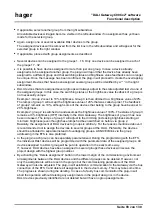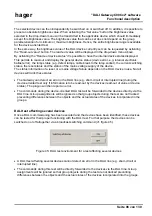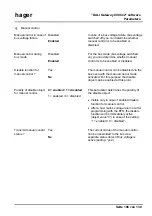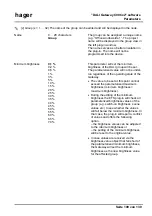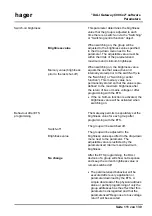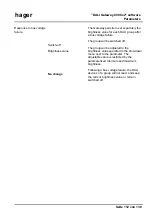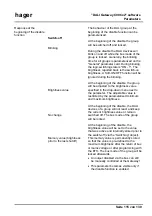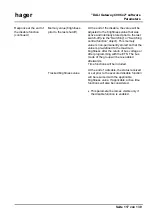
hager
"DALI Gateway C00Cx2" software
Parameters
Seite 107 von 130
Function and polarity of
status object
0 = inactive; 1 = manual
control is active
0 = inactive; 1 = permanent
manual control is active
This parameter specifies the information
contained in the status object. The object
will always be "0" if the manual control has
been deactivated.
The object will be "1" if the manual control
has been activated (temporarily or
permanently).
The object will be “1” only if the permanent
manual control has been activated.
•
This parameter is visible only if the
transmission of the manual control status
has been enabled.
•
After bus voltage return, the status will
be actively transmitted to the bus ("0")
only if a manual control that was
activated during bus voltage failure has
been terminated by the return of the bus
voltage. The status telegram will be
transmitted without delay.
Behaviour at the end of
permanent manual
control during bus mode
No change
Track outputs
The behaviour of the Gateway at the end of
the permanent manual control depends on
this parameter.
All telegrams received during an active
permanent manual control for direct control
(switching, dimming, brightness value,
scenes) will be discarded. After the end of
the permanent manual control, the current
status of all groups remains unchanged. If,
however, a forced-control position or a
disable function has been activated before
or during manual control, the Gateway will
set the response parameterized for this
function for the relevant groups.
During an active permanent manual control
all incoming telegrams are internally
tracked. At the end of the manual control
the groups will be set according to the
command received last or to the status that
existed prior to the manual control.
Bus mode of individual
groups can be disabled
Yes
No
Individual groups can be locally disabled
during a permanent manual control so that
the disabled groups can no longer be
addressed via the bus. A disable via
manual control will only be permitted if this
parameter has been set to “yes”.

